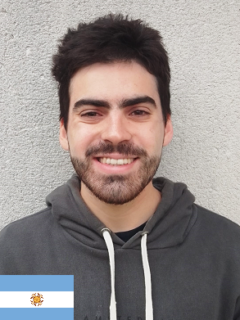Mateo Villavicencio
Mateo Villavicencio
Visiting student (National University of Mar del Plata, Argentina)
Microstructure, hydroxyapatite formation, and cytotoxicity of ion doped B containing bioactive glass scaffolds for bone regeneration
Supervisors: Usanee Pantulap, Prof. Aldo R. Boccaccini
Scaffolds are devices which mimic the extracellular biological matrix and are able to promote the regeneration of tissues after an injury. Bioactive glasses (BGs) are a very common choice of material for developing scaffolds for bone regeneration. In this work, three types of BG formulations will be
analyzed. They are an alternative to the well known 45S5 BG and present certain advantages in processing. 13-93 BG, 13-93B2 and CuZn-doped 13-93B2 BGs [1] will be analyzed in terms of their properties, such as: compressive strength, biodegradability, hydroxyapatite formation in simulated body fluid, and cytotoxicity. The scaffolds will be produced employing the foam replica method using PU foam cylinders as template [2]. This project is part of the I.DEAR program of Master student exchange between the Institute of Biomaterials (FAU) and INTEMA (National University of Mar del Plata, Argentina), funded by the Argentine-German University Center (CUAA-DAHZ).
[1] Schuhladen, K., Wang, X., Hupa, L., & Boccaccini, A. R. (2018). Dissolution of borate and borosilicate bioactive glasses and the influence of ion (Zn, Cu) doping in different solutions. Journal of Non-Crystalline Solids, 502, 22-34.
[2] Schuhladen, K., Pantulap, U., Engel, K., Jeleń, P., Olejniczak, Z., Hupa, L., … & Boccaccini, A. R. (2021). Influence of the replacement of silica by boron trioxide on the properties of bioactive glass scaffolds. International Journal of Applied Glass Science, 12(3), 293-312.

